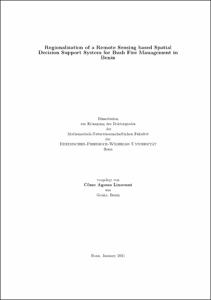Regionalization of a Remote Sensing based Spatial Decision Support System for Bush Fire Management in Benin

Regionalization of a Remote Sensing based Spatial Decision Support System for Bush Fire Management in Benin

| dc.contributor.advisor | Menz, Gunter | |
| dc.contributor.author | Linsoussi, Côme Agossa | |
| dc.date.accessioned | 2020-04-16T19:05:02Z | |
| dc.date.available | 2020-04-16T19:05:02Z | |
| dc.date.issued | 23.02.2011 | |
| dc.identifier.uri | https://hdl.handle.net/20.500.11811/4926 | |
| dc.description.abstract | Wildland fire agencies officers need objective and systematic information to make effective decision on fire management. Getting such information is usually challenging especially in developing countries where the required infrastructures or skills are not always available. Recent developments in the assessment of bush fires using remote sensing techniques and the availability of such results enable a systematic study of fire distribution and regime on different spatial scales. In this dissertation, we propose a development of a spatial decision support system for Bush fire monitoring called FIMAT (FIre MAnagement Tool), as well as a case study using the tool developed for Benin. The purpose of this study was (1) to grasp the theories of fire ecology and (2) state-of-art methods on vegetation fire assessment, (3) to develop a Spatial Decision Support System for Fire Management and (4), to regionalize its use to Benin for spatial and temporal fire distribution description. FIMAT is developed in Java using libraries such as Geotools, Jhdf. The fundamental data used by this system are MODIS burned area level 3 product along with auxiliary layers of geographic information. The MODIS burned areas product is derived from processing of combined MODIS-TERRA and MODIS-AQUA 500m land surface reflectance data using the Bidirectional Reflectance Distribution Function (BRDF) in a model-based change detection approach. This algorithm approximates the dates of burning by locating the occurrence of rapid changes in daily MODIS reflectance time series. FIMAT encompasses many processing and report functionalities. A data management system can automatically downloads the required fire data from MODIS Dataserver, if they are not available locally. A fire statistics calculator can generate the necessary information at small spatial scales (e.g municipality) from the original HDF data tile and save the result as Geotiff raster or other file formats. A map editor displays the processing results as a map along with additional layers. The created map can be customized by using the interactive integrated style editor and graphic editor and a chart editor shows generated statistics. Documents can be added to the project in Pdf format and viewed with the integrated Pdf viewer. The textual and graphical information generated by this monitoring tool can help decision makers to monitor and assess bush fire in simple way without them being necessarily specialists in Programming or Geographic Information Systems. It is an application with a simple user graphical interface. It is useful as a tool for operational assessment of compliance to the laws and arrangements. FIMAT has the following advantages over available tools (e.g Web Fire Mapper) - FIMAT can operate off-line; - it permits mapping of additional data layers; - it includes graphical editor and other useful reporting systems; - the maps and charts generated are highly customizable; - it offers more analysis and output options; - it allows assessment at subnational level (e.g communal level). From the investigations on spatial and temporal distribution of vegetation fire in Benin, it results that fire is a recurrent phenomenon in this region. It distribution in time and space follows approximately the same pattern over the studied period 2000-2009. Fires start usually in October and last until April/Mai with a maximum in December. Most of the burnings occur once at every location but some areas can burn two or three times a year. Those multiple burned areas are generally in protected areas where the fuel load is important and the vegetation more continuous. The multiple burned areas are usually extensions of late burned areas on early burned areas in their neighbourhood. | en |
| dc.language.iso | eng | |
| dc.rights | In Copyright | |
| dc.rights.uri | http://rightsstatements.org/vocab/InC/1.0/ | |
| dc.subject | SDSS | |
| dc.subject | Bushfire | |
| dc.subject | fire | |
| dc.subject | Spatial Decision Support System | |
| dc.subject | Benin | |
| dc.subject | Java | |
| dc.subject.ddc | 910 Geografie, Reisen | |
| dc.title | Regionalization of a Remote Sensing based Spatial Decision Support System for Bush Fire Management in Benin | |
| dc.type | Dissertation oder Habilitation | |
| dc.publisher.name | Universitäts- und Landesbibliothek Bonn | |
| dc.publisher.location | Bonn | |
| dc.rights.accessRights | openAccess | |
| dc.identifier.urn | https://nbn-resolving.org/urn:nbn:de:hbz:5N-24245 | |
| ulbbn.pubtype | Erstveröffentlichung | |
| ulbbnediss.affiliation.name | Rheinische Friedrich-Wilhelms-Universität Bonn | |
| ulbbnediss.affiliation.location | Bonn | |
| ulbbnediss.thesis.level | Dissertation | |
| ulbbnediss.dissID | 2424 | |
| ulbbnediss.date.accepted | 28.01.2011 | |
| ulbbnediss.fakultaet | Mathematisch-Naturwissenschaftliche Fakultät | |
| dc.contributor.coReferee | Greve, Klaus |
Dateien zu dieser Ressource
Das Dokument erscheint in:
-
E-Dissertationen (4337)




